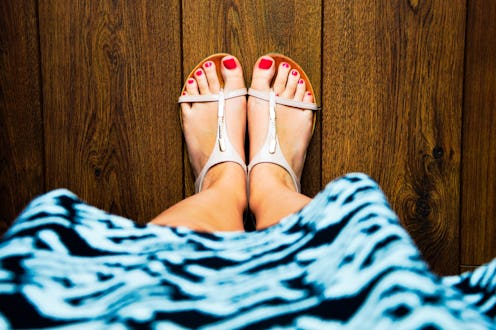Wearing high heels presents a pretty annoying set of challenges : They hurt like hell, and unless you're Carrie Bradshaw they really slow you down when it comes time to make a quick getaway down a cobblestone street. But aside from the regular wear and tear they cause to your feet, wearing high heels can also cause a more permanent (and really fking painful) problem: Bunions.
So what is a bunion, and how do bunions form? "There are five long bones, or metatarsals in the foot," explains Dr. Joan Oloff, podiatrist and creator of Joan Oloff Shoes. "When the foot pronates, or flattens out, the first metatarsal bones gets pushed up and over. This creates a 'bump' behind the big toe and is called a bunion." They're often hereditary, and can be exacerbated by wearing the wrong shoes. If you haven't experienced them yourself (consider yourself lucky), you may have seen them sticking out from the sides of other women's feet. And FYI? They really are as painful as they look.
According to Dr. Oloff, as frustrating as bunions might be, they don't necessarily need to mean the end of cute heels (or walking in general). Here are her tips for how to treat your feet with bunions, and five fabulous pair of shoes that will make wearing heels as painless as possible.
1. Keep An Eye Out For The Signs
Ilana, $455, Joan Oloff Shoes
"Some women start to notice an aching pain, while others notice a small bump developing behind the big toe first," says Dr. Oloff. "Listen to your foot. Never ignore pain. It is the body's protective warning mechanism." If left untreated, the bump will get larger and start to cause problems.
2. Wear The Right Shoes
Jessica Leopard, $395, Joan Oloff Shoes
If you find yourself with the beginnings of a bunion — and trust me, you'll know — you can make things more comfortable for your feet by avoiding shoes that cause pressure across the bunion area, which will exacerbate any discomfort. "Avoid shoes that have a particularly tight toe box," says Dr. Oloff. "Don’t be fooled by the shape of the toe box. There are squared toe boxes that are particularly bad for bunions yet they look like they would be OK."
It's important to try shoes on and walk around in them to make sure they aren't deceptively comfortable looking, which makes ordering online a real b*tch. These pointy-toe shoes from Dr. Oloff's line are designed to keep the pressure off of the bunion area, and will make wearing heels a lot more manageable.
3. Start Treating Early
Carmen Blue Printed Leather, $375, Joan Oloff Shoes
"General strengthening and flexibility exercises are helpful for the foot," says Dr. Oloff, who is a huge proponent of doing these things regularly before problems start to arise. As for after the bunions arise, she advises "symptomatic treatment, such as ice and anti-inflammatory medication."
4. Know When It's Time For Surgery
Charlize Bootie, $495, Joan Oloff Shoes
While there are some things you can do to ease the pain of bunions in the short term (aka the ones mentioned above), the only way to actually fix them is with surgery. "There are bunion splints that sometimes provide temporary relief of discomfort," says Dr. Oloff. "They will not fix the bunion, however. Only surgery can fix a bunion."
5. Remember: Bunions Are Not The End Of The World
Sara Black, $410, Joan Oloff Shoes
Don't worry — getting the beginnings of a bunion does not mean it's the end of life in high heels. But it also doesn't mean that you should force yourself to endure the pain of wearing uncomfortable shoes. "I am trying to help create a shift in the mindset of women regarding shoes in general," says Oloff. "We deserve to both look and feel good. If your shoes are causing bunion pain, throw them out!" Oloff's line is designed for style and comfort, and has dozens of options for women struggling to wear regular high heels. "I have cracked the code for creating beautiful shoes that feel good," she says. "Comfort never looked this good — women do not have to compromise!"
